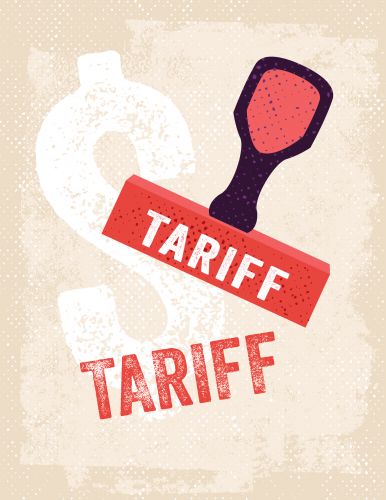(BRAIN) — Wednesday's reciprocal tariff announcement from President Donald Trump unveiled the global challenge the industry has been dreading for months. While the industry is still searching for answers about the tariffs' implementation, Trump's Rose Garden announcement made clear that price increases are inevitable. Only inventory that clears ports of entry before April 5 is safe from some level of extra tariff that will increase importers' costs and likely cause price hikes at wholesale and retail.
Importers now know that they will be making extra payments — due nearly immediately when the product arrives — that were not part of their long-range planning. That will tighten budgets across the industry, probably reducing spending in more flexible areas like marketing.
"The biggest problem for us and everyone is the cash flow," said Arnold Kamler, the chairman of Kent International. "When we buy bicycles and bike parts, we get credit terms of 60-90-120 days, but with high tariffs they get deducted from our checking account automatically; we have an auto debit with US customs, and I assume most of the big bike companies do," he said. "It's brutal."
Some critcal details remain unknown across the industry.
"I think the (industry's) initial reaction will be to wait for more clarity (if any is to be had)," Matt VanEnkevort, Marin Mountain Bike's CEO, told BRAIN in an email.
VanEnkevort said it's too soon to predict the size of price increases — details are still unknown and there's always the possibility that Trump will retract the new tariffs.
"I would think that (the administration's) recent history of announcing and then retracting trade sanctions will make most brands reluctant to jump into price increases," he said. But, he said, "If this does actually come into effect, this will increase dealer and consumer pricing substantially. Not going to help bike dealers," he said.
The broad picture from Wednesday is that all imported goods, from all nations, are receiving an additional 10% tariff on top of any pre-existing duties or tariffs. Where certain products from certain countries already had multiple tariffs — such as some steel products from China — the new total tariffs due could be approaching 100%. Other bike-product supplying regions whose products had been subject to relatively small U.S. tariffs in the past — including Europe, the U.K., Taiwan, Cambodia, Vietnam, and Malaysia — are set to receive substantial new tariffs.
According to PeopleForBikes, the new tariff base rates from key countries are:
- Vietnam: 46%
- Taiwan: 32%
- Japan: 24%
- Thailand: 36%
- EU: 20%
- Indonesia: 32%
- Malaysia: 24%
- Cambodia: 46%
- India: 26%
The broad global nature of the new tariffs leaves the industry few or no escape routes. Offshoring from China to another Southeast Asian nation, for example, might provide only marginal relief.
And perhaps most importantly, as VanEnkevort noted, the second Trump administration, in a few short months, has demonstrated a capriciousness that leaves business leaders wary of making major decisions about sourcing.
Many hope the tariffs will lead to increased domestic manufacturing. And some brands that already manufacture here, or that have new domestic manufacturing projects underway, will benefit at least in the short term, if not the long.
But setting up manufacturing requires substantial capital outlay, and in an odd twist, much of the equipment, raw materials and sub-components required to open and run a U.S. factory are imported, so new tariffs on those purchases will discourage such investments at least until things become more certain.
Large global brands that have the resources to open a major factory — whether owned by U.S., Asian, or European parent companies — are likely to choose other manufacturing locations than the U.S. That's because, first, the U.S. represents a small percentage of the global bike market and, second, other nations and regions have demonstrated more stability and provide more government support for bike manufacturing.
Legislation introduced in Congress would reduce tariffs on OE components, encouraging domestic bike assembly, and also provide loans for domestic bike makers. If it passes, it would encourage domestic manufacturing, but it's unclear whether the Republican Congress and White House would support the bike industry at a time when even bike-path projects are being canceled.
Many industries selling goods in the U.S. face the same issues. But the bike industry has a few of its own realities right now. They include channel inventory: Some bike and e-bike brands remain over-inventoried in some categories, as continued discounting reveals.
The good news is the old excess inventory could sell more quickly this year because it will be even cheaper relative to inventory brought in under the new tariffs. However, brands that have successfully reduced their inventory may now be at a disadvantage. That includes startups and other small brands that have taken advantage of the increased manufacturing capacity that opened up in Asia in the last couple years after major brands cut off their ordering.
The macro concerns
But the bike industry specifics are starting to pale in comparison to concerns about the larger economy. Many industry leaders don't like to talk about it, preferring to focus on their own knitting.
"I hate it when people get on TV or, you know, on the media and talk about a recession because if you start scaring people, then people will certainly start behaving like there is a recession," the CEO of one small bike brand told BRAIN in an interview earlier this week. "But yeah ... the current trajectory doesn't look amazing for that," the CEO conceded.
The same CEO noted that macro concerns about the economy — including a possible recession, stagflation, a decline in consumer confidence, and more — make the industry's micro concerns look, well, micro.
"The macro concerns are way scarier to me than whether our frames are going to be a little bit more expensive," the CEO said.


